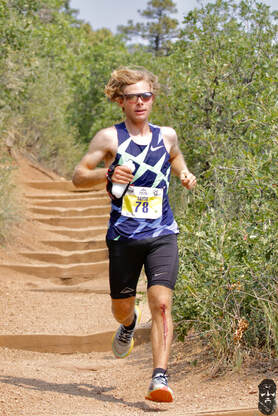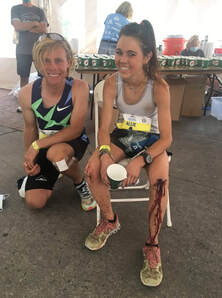Tayte Pollman, American Trail Running AssociationTayte is a 2x Pikes Peak Marathon runner, placing 4th OA in 2020. He had an impressive overall time of 3:52 with a 2:22:55 ascent and 1:29:05 descent!  Tayte Pollman, Photo Credit: Peter Maksimow Tayte Pollman, Photo Credit: Peter Maksimow This is an excerpt from the "Pikes Peak Ascent and Marathon Training Guide" written by Tayte Pollmann for the American Trail Running Association and is reprinted here with permission. To read the entire article visit: https://trailrunner.com/trail-news/pikes-peak-ascent-and-marathon-training-guide/ The Pikes Peak Training Guide The Pikes Peak Ascent and Marathon is one of the most unique trail running events to prepare for. In the training guide below, I outline some of the main challenges to train and prepare for in this race, weather considerations, essential gear and tips for spectators. Training Considerations Altitude: Few trail races reach an altitude of above 14,000 feet (or 4,000 meters), making altitude training one of the most important aspects of this race. Endurance running performance is negatively impacted by high altitudes. In high altitude environments, there is less oxygen in the air and the body is not able to provide the same quantity of oxygen-rich blood to fuel muscles. At the summit of Pikes Peak, there is approximately 43% less oxygen in the air than at sea level, and running at such an extreme elevation will significantly slow your pace. You may find yourself with dizziness, brain-fog, decreased motor skills and shortness of breath. Although running at 14,000 feet will never be easy, there are ways to prepare yourself for the altitude. Spending time sleeping or training consistently at high altitude allows your body to adapt to the lack of oxygen in the air. In response to living and training at high altitude, your body will increase red blood cell and hemoglobin production to more efficiently deliver oxygen to your muscles. Such adaptations typically take at least three to four weeks of living at this higher altitude to have full effect, though some athletes will claim to notice adaptations in shorter one to two week altitude training camps. If you don’t live at altitude or aren’t able to partake in an altitude training camp, many sports scientists suggest that the closest training technique to mimic altitude training is heat training. The added difficulty of running in extreme heat will help prepare you for altitude running and will give you a better idea of what pace you can expect to run on Pikes Peak. Lastly, if you have never been at 14,000 feet, I highly suggest experiencing it at least once before the race. The Pikes Peak Highway and Cog Railway offer visitors of the mountain a quick and easy way to reach the summit by car or train (the Cog Railway requires a reservation). I’d highly recommend showing up to the race a few days early to spend time noticing how your body feels at 14,000 feet. Even just standing or walking around at this altitude may affect your body in interesting ways and it’s good to know these effects before race day. Vertical Gain: There are few races where the course gains as much elevation in a single push with relatively few downhills. In spite of a few minor dips, the course steadily climbs over 7,800 feet in 13.1 miles from downtown Manitou Springs to the summit of Pikes Peak. Even in Colorado where there are fifty eight peaks over 14,000 feet, there are few trails as long or that climb nearly as much as Barr Trail on Pikes Peak. For that reason, there is no better way to prepare yourself for the elevation gain of Pikes Peak than by running up it. If you live in the Pikes Peak region, I’d highly recommend running the entire route from bottom to top at least once in your pre-race preparations. Run lower sections of Barr Trail as soon as the snow melts. For the majority of runners in the race without easy access to Pikes Peak, you should prioritize a combination of long, steady paced runs and elevation gain. Treadmills are a great tool for this. For example, plan a two hour treadmill run set to an incline of 5% to 10% grade to give you a good sense for the kind of monotonous uphill grind you will experience on Pikes Peak. For marathon racers in particular, there is also the consideration of training your legs for the downhill. After having completed the marathon course in 2020, I can attest that the most difficult part of the race for me was the later sections of downhill when I felt as if my legs had been beaten to JELL-O by the repetitive downhill pounding. Marathoners should make sure to accumulate plenty of race-paced efforts (not just easy running!) on downhills and/or supplement with gym work that targets quadricep strength and balance. Overall, you should be prepared to run what is likely to be the longest continuous downhill and/or uphill of your life. Pacing: This is one of the easiest races to have a “blow up” or complete energy bonk, typically due to pacing mistakes. In a typical race, you might push too quickly at the beginning of a race but there are often points in the course on downhills or flater sections where you can recover and settle into your pace. Make sure you concentrate on your pace and don’t get caught up in trying to keep up with another runner and don’t expend energy trying to pass the person in front of you only to slow down once you have overtaken the person. The altitude and relentless nature of the uphill in the Pikes Peak Marathon make it difficult to get out of an energy deficit once you’re in it. For this reason, it’s essential that you begin the race at an easy pace and don’t find yourself struggling too much on the climb to Barr Camp aid station. Remember that as the altitude increases, so too will the demands on your body. You should attempt to arrive as fresh as possible to the final three miles below the summit. For those who have run a road marathon (26.2 miles), one helpful pacing tip is that you can expect to reach the summit (mile 13.1) in about your expected road marathon finish time. For example, if you run a 3 hour and 30 minute road marathon, you can expect to reach the summit of Pikes Peak in a similar time. If you are an experienced trail runner who excels at high altitude running, you may reach the summit slightly faster than your marathon time. In contrast, if you are newer to trail running it may take slightly longer than your marathon time to reach the summit. In general, don’t let yourself get in a “hole” early on and expect to run slow or hike! Key Challenges A-Frame: At approximately three miles to the summit, runners reach treeline (11,950 feet) at a section of the course known as “A-Frame.” This section is named after an A-frame shelter located near the course at this point. From A-Frame to the summit is described by many racers as the most challenging part of the entire race. In this section, runners face over 2,000 feet of elevation gain and average grade of 12.4%, all at the highest altitudes of the race. Race leaders have lost their leads in this section or transitioned from smooth running to dizzy hiking in a matter of minutes. In order to prepare for this section, I suggest two things: save your energy and fuel frequently. Firstly, take your time on your way up to Barr Camp aid station (mile 7.6) and consider taking a short break at Barr Camp to let your heart rate drop before making the climb up to A-Frame. This can help you avoid crashing at A-Frame and give you the extra boost you need for the higher altitudes to come. Secondly, proper fueling is essential above A-Frame. Higher altitudes require your body to burn higher amounts of carbohydrates for fuel and it’s also easier to become dehydrated without feeling thirsty. Both a lack of carbs and fluids can be detrimental to race performance and lead to fatigue. In order to properly fuel at altitude, make sure to take frequent sips (not huge gulps) of water/electrolyte mix and small bites of carbohydrate rich foods at least every 15 minutes. 16 Golden Stairs: The final challenge below the summit is known as the “16 Golden Stairs.” A stair refers to a set of switchbacks in the trail. This section refers to the final 32 switchbacks below the summit of Pikes Peak (you will see a sign “16 Golden Stairs” on the trail, though I’d advise not trying to count all of the switchbacks!). In contrast to the dirt and loose gravel encountered on the majority of the course, the 16 Golden Stairs is largely rocky terrain with frequent rock step-ups of 10 to 15 inches. By this point in the race, your legs are likely to be tired and it can be difficult to manage the more technical terrain. 1995 Pikes Peak Ascent Runner-Up, Dan Vega, gives his advice on managing the Golden Stairs, “All the pain goes away once you cross the finish line, so hold nothing back!”. In order to prepare for this challenge, I would practice spending time on technical terrain and performing stair climber or “box step up” workouts. Firstly, spending time on technical terrain will help prepare your mind to pick the right lines to take on the trail. Instinctively learning when to step on or around a rock can add up to large energy savings throughout the race. It will also help your muscles become accustomed to the additional balance challenges associated with rocky terrain. Secondly, gym workouts involving stair climbing or box jumping can help you become more efficient at climbing over technical terrain. These workouts aid in recruiting leg muscles needed to manage difficult terrain and will increase your overall leg strength, leading to less fatigue and more graceful running/hiking over rocks. Weather Considerations: High alpine environments are known for unpredictable and volatile weather conditions. In previous editions of the race, runners have been turned around due to severe lightning storms and the 2018 Pikes Peak Ascent was shortened to a race to Barr Camp (see below) because of potential for a life-threatening hailstorm. Last year in 2021, The Pikes Peak Ascent experienced a snowstorm on the summit while conditions below in Manitou Springs were relatively mild. Many runners were unprepared for the cold when they reached the summit. Even though you are in a race, remember that you are in a potentially dangerous mountain environment where weather can change from beautiful to stormy in a matter of minutes. In contrast to constant threats of snow, hail, and cold temperatures, the race can also be very hot. Traditionally held in August (though the 2022 edition will be held in September), temperatures can reach 90 degrees Fahrenheit in Manitou Springs during the afternoon. Marathoners should be especially concerned with the weather as they will be on the mountain for the longest and encounter the most extreme temperature changes. Prepare for both the hot and cold! Essential Equipment Lightweight Rainproof Jacket: Due to the threat of storms above tree-line (even on sunny days), it’s a good idea to have a lightweight rainproof jacket with sealed seams. This can protect you from the sting of harsh winds and keep you dry in case of precipitation. Such jackets store easily in a running vest or belt and are light enough not to be a nuisance even if you are aiming for a competitive overall or age-group placement. Gloves: Many people don’t appreciate the importance of this tip until they fall! Pikes Peak Marathoners should wear gloves on the descent to save their hands from cuts, and scrapes should they fall. It’s extremely common for runners to fall in this race due to the combination of technical terrain on the 16 Golden Stairs, fast descending on loose gravel and scree, and high altitude “brain-fog.” You may fall, but at least you can save yourself from bloody hands! Carry a lightweight pair for the descent, or wear gloves the entire way to retain heat. If your feet, hands, and head are warm you will be much more comfortable. Fluids and Calories: Running in high-altitude environments requires more calories (carbohydrates in particular) and can more easily cause dehydration. Although the course has eight aid stations, it’s still a good idea to have calories and fluids with you. I’d suggest bringing a bottle, hydration pack, or soft collapsible flask for fluids. For calories, you can either ingest them in your drink mix or bring easily portable items such as gels or chews that store easily in a vest or pockets in your shorts or tights. PRO TIP: Two-time Pikes Peak Marathon Champion and four-time Pikes Peak Ascent champion, Anita Ortiz, shares her nutrition and hydration tips for the Pikes Peak Marathon: “Nutrition and hydration are extremely important when running the Pikes Peak Marathon. You need to have your ‘wits about you’ at such a high elevation and navigating rocky terrain. I always start eating and drinking early and often, taking little sips and nibbles every five to ten minutes. As I climb higher, it becomes harder to take in the calories, but if I’ve started early and kept at it, I feel okay in the final two miles up to the summit. As I descend, my tummy gets happier again, and I start sipping and nibbling to the finish.” Trail Running Shoes: Trail running shoes will help you run faster on this course. Trail shoes will provide you with grip on loose dirt and help you better manage roots and switchbacks in the beginning and middle of the trail, as well as the more technical rocky sections towards the summit. If you are running the Ascent, I suggest wearing an extremely lightweight, minimal (low-stack height) trail shoe designed for racing or uphill running in particular. For marathoners, choose a trail shoe that is lightweight but also has a good mix of agility and cushion. The downhill will beat up your feet and you should wear shoes that save you from this repetitive pounding. Sunglasses and Sunscreen: Sunglasses and sunscreen are important accessories for high-altitude race environments. UV radiation from the sun is significantly more intense at higher altitudes and can cause permanent eye damage, even on cloudy days. Choose sunglasses with higher levels of UV protection such as those with Category Two and Three rated lenses. Likewise, choose a sunscreen product that provides optimum protection and one that allows your skin to breathe and doesn’t come off when you sweat. Passing: In the Pikes Peak Marathon, you should expect two-way traffic from runners going uphill and downhill. Elite runners reach the summit in at least half of the time that it takes the average runner. If you expect to be in the mid to back of the pack, keep your eyes peeled for the top runners descending at fast speeds even before you reach Barr Camp. The trail can be narrow in many spots, so make sure to use extra caution in these sections. Also, should you choose to pass other runners, make sure to provide the runner you’re passing with a cue such as “On your left!” or wait to pass until you reach wider sections of trail. PRO TIP: Did you know the entire Pikes Peak Marathon course is on Google Maps street-view? In 2017, the American Trail Running Association partnered with Google Maps to capture 360 degree panoramic images of every foot of the 13.1 mile route. Learn more about the project and see the trail on our Pikes Peak Trekker page - https://trailrunner.com/explore/pikes-peak-trekker/ Comments are closed.
|
©
Pikes Peak Marathon


